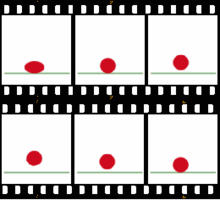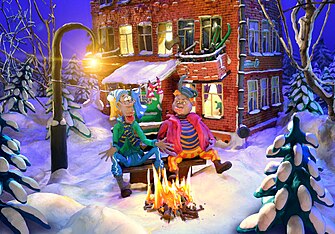
| Main | Categories and topics | Tasks and projects |
Introduction
Animation is a filmmaking technique by which still images are manipulated to create moving images. In traditional animation, images are drawn or painted by hand on transparent celluloid sheets (cels) to be photographed and exhibited on film. Animation has been recognized as an artistic medium, specifically within the entertainment industry. Many animations are computer animations made with computer-generated imagery (CGI). Stop motion animation, in particular claymation, has continued to exist alongside these other forms.
Animation is contrasted with live-action film, although the two do not exist in isolation. Many moviemakers have produced films that are a hybrid of the two. As CGI increasingly approximates photographic imagery, filmmakers can easily composite 3D animations into their film rather than using practical effects for showy visual effects (VFX). (Full article...)
Selected article
"Ricardio the Heart Guy" is the seventh episode of the first season of the American animated television series Adventure Time. The episode was written and storyboarded by Bert Youn and Sean Jimenez, from a story by Merriwether Williams, Tim McKeon, and Adam Muto. It originally aired on Cartoon Network on April 26, 2010. The episode guest stars George Takei (pictured) as the titular character, Ricardio. In this episode, Finn believes that Princess Bubblegum's (voiced by Hynden Walch) new friend, a heart named Ricardio, is evil, and is proven right after learning that Ricardio is the heart of the Ice King (voiced by Tom Kenny). Ricardio reveals that he wants to "make out" with Bubblegum's heart, but he is defeated by Finn and Jake. Ricardio would become a minor recurring villain, reappearing in the fourth season entry "Lady & Peebles". After the episode aired, series composed Casey James Basichis posted a video explaining his inspiration and the method in which he produced the music featured in the episode. Basichis largely scored the episode with opera music, because he felt the genre suited Ricardio. "Ricardio the Heart Guy" was watched by 1.91 million people and received largely positive critical attention, with many reviews praising Takei's voice work.
Selected image
Did you know (auto-generated) -

- ... that the animated film The Exigency took thirteen years to make?
- ... that the interactive cartoon Cat Burglar takes about 15 minutes to watch, but features 90 minutes of animation?
- ... that, for the animated film Us Again, director and writer Zach Parrish considered a video of an elderly couple dancing to be visceral and ideal inspiration?
- ... that Bruce Timm created most of the character designs for Batman: The Animated Series?
- ... that the Tuca & Bertie episode "The Jelly Lakes" employs a paper-cutout animation that helps to depict abuse in a way that centers the victim's story?
- ... that the Pakistani film Shehr e Tabassum was the first animated cyberpunk film to be made by an Urdu development team?
Selected quote
Selected biography
Matthew Abram "Matt" Groening (born February 15, 1954) is an American cartoonist, screenwriter and producer. He is the creator of the comic strip Life in Hell as well as two successful television series, The Simpsons and Futurama. Groening made his first professional cartoon sale of Life in Hell to the avant-garde Wet magazine in 1978. Life in Hell caught the attention of James L. Brooks. In 1985, Brooks contacted Groening with the proposition of working in animation for the Fox variety show The Tracey Ullman Show. The shorts would be spun off into their own series: The Simpsons, which has since aired 768 episodes. In 1997, Groening, along with former Simpsons writer David X. Cohen, developed Futurama, an animated series about life in the year 3000, which premiered in 1999. After four years on the air, the show was canceled by Fox in 2003, but Comedy Central commissioned 16 new episodes from four direct-to-DVD movies in 2008. In 2002, he won the National Cartoonist Society Reuben Award for his work on Life in Hell.
Selected list
The episodes of The Bellflower Bunnies, a children's animated series based on the Beechwood Bunny Tales books by Geneviève Huriet, Amélie Sarn and Loïc Jouannigot. It debuted on TF1, a French television network, on 24 December 2001. The series is written by Valérie Baranski, and produced by Patricia Robert. The show centres on the adventures and exploits of the Bellflower family, a clan of seven rabbits who live in Beechwood Grove. The two adults in the family, Papa Bramble and Aunt Zinnia, take care of their five children: Periwinkle, Poppy, Mistletoe, Dandelion and Violette. The series has also been broadcast on CBC Television and TFO in Canada, KI.KA in Germany, Portugal's RTP in the Azores, and in several other countries. The show has fifty-two episodes: four in the first season, twenty-two in the second, and twenty-six in the third. In the entire series, thirteen are based directly on installments in Beechwood Bunny Tales, published by Milan Presse of France and Gareth Stevens in the United States; the rest are based on scripts by Valérie Baranski. Distributors in Europe, North America, and South Korea have released DVDs of the first two seasons.
More did you know...
- ...that the designers of Cabbage Patch Kids created Selchow and Righter's Scrabble People, the title characters of 1985's syndicated cartoon special A Pumpkin Full of Nonsense?
- ...that Monty Oum, the creator of Rooster Teeth Productions' upcoming series RWBY, was concerned that the show focused on female characters but was being developed by a mostly male crew?
- ...that during his 64-year career, animator Bob Givens created the first official design for Bugs Bunny?
Anniversaries for June 15
- Films released
- 1923 – Felix Gets Broadcasted (United States)
- 1924 – Felix Finds 'Em Fickle (United States)
- 1925 – Alice Loses Out (United States)
- 1951 – Double Cross Country Race (United States)
- 1979 – Pink Pull (United States)
- 1990 – Roller Coaster Rabbit (United States)
- 1994 – The Lion King (Walt Disney Pictures, United States)
- 2001 – Atlantis: The Lost Empire (Walt Disney Pictures, United States)
- 2018 – Incredibles 2 (Pixar, Walt Disney Pictures, United States)
- Television series and specials
- 2005 – CatDog, an American animated television series finishes airing on Nickelodeon
- 2012 – Gravity Falls, an American animated television series begins airing on Disney Channel
Subportals
Related portals
Wikimedia
The following Wikimedia Foundation sister projects provide more on this subject:
-
Commons
Free media repository -
Wikibooks
Free textbooks and manuals -
Wikidata
Free knowledge base -
Wikinews
Free-content news -
Wikiquote
Collection of quotations -
Wikisource
Free-content library -
Wikiversity
Free learning tools -
Wiktionary
Dictionary and thesaurus
























